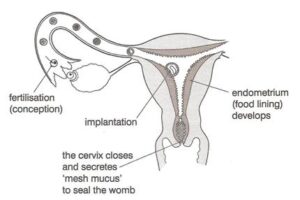Factors necessary to achieve pregnancy include the following:
- A healthy mature ovum.
- A healthy mature sperm.
- A healthy patent fallopian tube through which the sperm travels to fertilize the ovum and the fertilized ovum travels to the uterus.
- An endometrium that has been prepared to accept a fertilized ovum first by the action of oestrogen before ovulation, and then by the action of progesterone after ovulation.
- A healthy corpus luteum for the secretion of adequate levels of progesterone to maintain the pregnancy in the uterus until the placenta takes over this function at 8 weeks gestation.4
- Cervical Mucus: Pregnancy cannot occur without the presence of more-fertile type cervical mucus as the function of this type of mucus (L mucus, S mucus) is to attract sperm, to transport sperm, to nourish sperm and to filter sperm.1
- A healthy life style that is well balanced between work and leisure with a well balanced diet.2
Fig. 6-16: Diagram of Ovulation & Fertilisation

The more-fertile mucus transports sperm from the cervical os to the uterus and both fallopian tubes The ovum has been released from the ruptured Graafian follicle in the ovary (i.e. ovulation has occurred), and one sperm has reached the outer end of the left fallopian tube and is about to fuse with the ovum (fertilization). In the ovary, the granulosa cells in the wall of the Graafian follicle become the corpus luteum which secretes progesterone to support the pregnancy until the placenta takes over this function at 8 weeks gestation.4 (see Fig. 6-17).
Fig. 6-17; Transport of the fertilised ovum to the uterus – implantation:
 The ovum is fertilized in the outer end (the ampulla) of the fallopian tube; the fertilized ovum is called a zygote. Once the zygote begins to divide it is called an embryo. The embryo starts to divide rapidly during its passage through the fallopian tube and on Days 3-4 enters the uterine cavity at the 8-16 cell stage (morula); the morula is transformed to a blastocyst
The ovum is fertilized in the outer end (the ampulla) of the fallopian tube; the fertilized ovum is called a zygote. Once the zygote begins to divide it is called an embryo. The embryo starts to divide rapidly during its passage through the fallopian tube and on Days 3-4 enters the uterine cavity at the 8-16 cell stage (morula); the morula is transformed to a blastocyst
during the 5th to 6th day after fertilization when the embryo is at the 16 to 32 cell stage. On the seventh day after ovulation, the blastocyst implants on the endometrial lining of the uterine cavity.4 The implanting blastocyst starts secreting human chorionic gonadotrophic hormone (hCG) which prevents the demise of the corpus luteum. Progesterone from the corpus luteum supports the pregnancy for 8 weeks after conception after which the embryo is capable of synthesizing all steroid hormones required for its development.3,4 (Fig.6-17 from the Fertility Education Trust UK, 2003, is used with the kind permission of Colleen Norman).
References
- Erik Odeblad; ‘The discovery of different types of cervical mucus and the Billings Ovulation Method’; Bulletin of the Ovulation Method Research and Reference Centre of Australia, Vol 21, No 3; 3-35; Sept 1994. ( online if you google ‘Erik Odeblad, cervical mucus’).
- Hanna; ‘Natural Family Planning – Is it scientific? Is it effective? see pages13,14; Newman Lecture Series 1-May 21, 2000. (online).
- Manassiev Nikolai, Whitehead, Malcolm; ‘Female Reproductive Health’; 2004, ISBN 1-85070-491-0
- Griffin James E, Ojeda, Sergio R; ‘Textbook of Endocrine Physiology’; 1996, p226-228; ISBN 0-19-510755-1(pbk).


